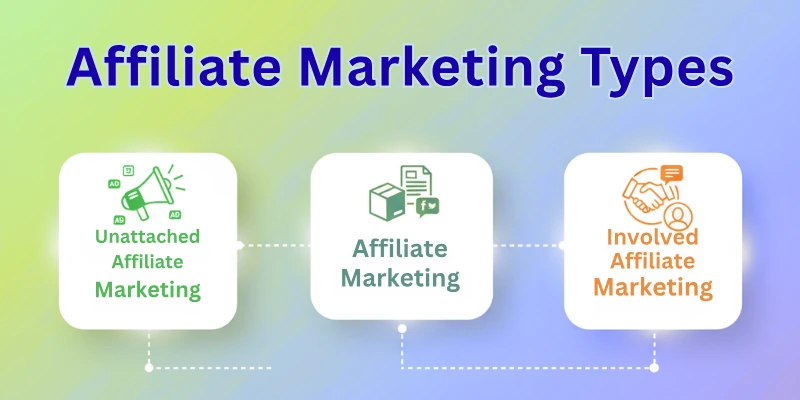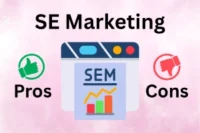Types of Affiliate Marketing: Explained with Pros & Cons
Published: 19 Aug 2025
Have you ever seen someone online promoting a product they love? Maybe it’s a beauty blogger recommending their favourite makeup or a tech reviewer recommending a new laptop.
This is a type of affiliate marketing, and there are actually many ways to do it!
This article will explain the different types of affiliate marketing, so you can find the best fit to start earning money yourself.
Types of Affiliate Marketing
There are three major types of affiliate marketing:
- Unattached Affiliate Marketing
- Related Affiliate Marketing
- Involved Affiliate Marketing

Now, let’s learn about these different ways of affiliate marketing in detail.
1. Unattached Affiliate Marketing
Unattached affiliate marketing is when you promote products without having any connection with your audience. You don’t use the product, you don’t create content about it, and you don’t have a personal relationship with the people who might buy it. Your role is just to place links or ads, and if someone clicks and buys, you earn money.
How it works
- You find a product to promote.
- You run ads (like Google Ads, Facebook Ads, banner ads).
- People click those ads, go to the product page, and if they buy → you get a commission.
Real-Life Example
Think of billboards you see on the road. The person who put them up doesn’t know you personally, but if you buy something because of that ad, they make money. Online, it’s the same with random banner ads, pop-ups, or sponsored links.
Advantages
- Easy to start – no need for a blog, website, or audience.
- No need for expertise – you don’t have to know or use the product.
- Scalable – you can run multiple ads for many products.
Disadvantages
- Low trust – people rarely trust ads from strangers.
- Low conversions – fewer people actually buy, even if they click.
- High cost – ads cost money, and if people don’t buy, you lose.
- Traffic heavy – to make money, you need thousands of visitors.
Summary: This type is fast to start but risky and not very effective unless you have a big advertising budget.
2. Related Affiliate Marketing
Related affiliate marketing means promoting products that are connected to your niche or audience. You don’t have to personally use the products, but they should make sense for the type of content you share.
How it works
- You choose a niche (fitness, tech, travel, fashion, etc.).
- You create blogs, YouTube videos, or social media posts related to that niche.
- Inside your content, you recommend products that your audience might find useful.
- When your audience buys through your affiliate link, you earn a commission.
Real-Life Example
- A travel blogger writing about “Top 10 Must-Have Gadgets for Travelers” and linking to backpacks, power banks, or travel pillows.
- A tech blogger writing “Best Budget Laptops for Students” and linking to laptops on Amazon.
Advantages
- Targeted audience – people are already interested in your niche, so sales are easier.
- Less traffic needed – compared to unattached, you don’t need millions of visitors to make money.
- Content builds trust – useful articles, reviews, or tutorials increase credibility.
Disadvantages
- Time investment – you need to keep creating content to stay visible.
- Audience knowledge required – you must understand what your readers want.
- High competition – many others in the same niche might promote the same products.
Summary: Safer and more effective than unattached. Best if you have a blog, YouTube channel, or social media following.
3. Involved Affiliate Marketing
Involved affiliate marketing is the most personal and trusted type. Here, you only promote products that you’ve actually used, tested, and trust. You share your real experiences and show your audience how the product worked for you.
How it works
- You try a product yourself (software, tool, gadget, etc.).
- You write or record honest reviews, tutorials, or case studies.
- Your audience sees your results and trusts your recommendation.
- They buy through your link → you earn money.
Real-Life Example
- A fitness YouTuber using and reviewing a protein supplement they personally take.
- A blogger writing about “How I Built My Website with WordPress + Hosting Review” after using the hosting service.
- A makeup influencer showing before-and-after results of a skincare product.
Advantages
- High trust – people believe real experiences more than random ads.
- High conversions – since your audience trusts you, more people buy.
- Stronger brand – you build long-term authority and a loyal following.
Disadvantages
- Limited options – you can only promote products you’ve tried.
- Time-consuming – you must test products before recommending them.
- Effort required – creating detailed reviews, tutorials, or case studies takes work.
Summary: This type gives the best long-term results but requires patience, real product use, and honesty.
Comparison of Affiliate Marketing Types
Here is a quick comparison between three different types of affiliate marketing:
| Type | Connection with Audience | Content Needed | Trust Level | Conversion Rate | Best For |
| Unattached | None | No content, just ads | Very Low | Low | Beginners with ad budget |
| Related | Moderate (topic-based) | Blogs, videos, posts | Medium | Medium | Bloggers, YouTubers, niche creators |
| Involved | Strong (personal experience) | In-depth tutorials, reviews | High | High | Influencers, experts, long-term brand builders |
Final Takeaway:
- Unattached = Quick start, but low trust and high risk.
- Related = Safer, more targeted, needs effort and content.
- Involved = Most trusted, best long-term, but requires personal use.
Choosing the Right Type of Affiliate Marketing
There are a few things to think about when choosing which type of affiliate marketing to try:
- Your niche: This is your area of expertise or the topic your content focuses on (e.g., technology, fitness, travel). Picking products related to your niche makes your recommendations more relevant and trustworthy.
- Your audience: Who are you trying to reach? Understanding audience interest will help you choose products that they’ll buy.
- Your content creation skills: Do you enjoy writing blog posts, creating videos, or designing graphics? Choose a method that fits your expertise and allows you to create engaging content.
- Time and effort: Some methods require more work upfront (like creating in-depth reviews) than others (like displaying banner ads). Consider how much time you can dedicate to creating content.
- Building trust: No matter which method you choose, focus on being honest and recommending products you genuinely believe in.
By considering these factors, you can choose the type of affiliate marketing that allows you to be most successful!
Pros & Cons of Affiliate Marketing
Here are some major advantages and disadvantages of affiliate marketing.
Pros of Affiliate Marketing
- Low Startup Costs: You don’t need a lot of money to start.
- Passive Income: Earn money even when you aren’t working.
- Flexible Schedule: Work whenever and wherever you want.
- No Customer Support: The merchant handles all customer issues.
- Variety of Products: Promote many different products.
- Performance-Based: You earn more if you work harder.
- Easy to Join: Many affiliate programs are free to join.
- No Inventory: You don’t need to store or manage products.
- Global Market: You can reach customers all over the world.

Cons of Affiliate Marketing
- High Competition: Many people are doing it, so it’s competitive.
- Income Fluctuations: Your earnings can go up and down.
- No Control Over Products: You have no say in the product quality or price.
- Dependence on Merchant: If the merchant changes the program, it affects you.
- Payment Delays: Sometimes, you might have to wait to get paid.
- Requires Time: It takes time to build an audience and trust.
- Risk of Scams: Some affiliate programs can be scams.
- Strict Rules: Affiliate programs may have strict guidelines.
- Need for Marketing Skills: You need to learn and use marketing strategies.
Conclusion
So guys, in this article we’ve covered the three main types of affiliate marketing: unattached, related, and involved!
Choosing the best type boils down to your unique situation.
For me, if I was just starting out, I’d be tempted to try unattached marketing first. It’s a good way to get your feet wet and see what kind of products generate interest with your audience. But I wouldn’t focus on it for long-term success.
Related affiliate marketing feels like the sweet spot. Once you have a niche and a following, you can build trust by recommending products that truly align with your content and your audience’s needs.
However, if there are products I absolutely love and use every day, involved affiliate marketing feels like the most natural fit. Sharing my genuine passion can lead to some powerful results.
The key takeaway? Experiment, find what works for you, and always prioritize building trust with your audience. With the right approach and dedication, affiliate marketing can be a fantastic way to turn your passion into profits!
FAQs
Here are some of the most commonly asked questions related to affiliate marketing types:
Unattached affiliate marketing is usually the easiest. You don’t need a niche, a blog, or even content to start. You simply promote products through ads or links. This makes it quick to set up for beginners.
Not always. Since you don’t target a specific audience, the products may not match their needs. This usually means fewer people will buy, so conversions are low. Other types of affiliate marketing can bring better results in the long run.
Related affiliate marketing is the best choice for you. You can promote healthy cookbooks, kitchen gadgets, or grocery delivery services. These products match your recipes, so your audience will find them useful. This way, your promotions feel natural and helpful instead of random.
It is not always required to use the product yourself. But if you promote products you know and trust, people will believe you more. This is called involved affiliate marketing, and it builds stronger trust. Honest recommendations usually bring better results over time.
Always be honest about what you recommend. Promote high-quality products that can truly help your readers. Don’t make your blog or page look like only ads. Useful and genuine content makes people trust your advice.
Yes, you can mix different types of affiliate marketing. For example, you may use related affiliate marketing on your blog while trying unattached ads. Testing different methods shows you what works best. Over time, you’ll find the strategy that fits your audience.

- Be Respectful
- Stay Relevant
- Stay Positive
- True Feedback
- Encourage Discussion
- Avoid Spamming
- No Fake News
- Don't Copy-Paste
- No Personal Attacks

- Be Respectful
- Stay Relevant
- Stay Positive
- True Feedback
- Encourage Discussion
- Avoid Spamming
- No Fake News
- Don't Copy-Paste
- No Personal Attacks





